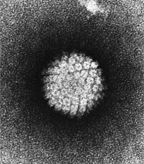HPV DNA Test Better Than Pap Smear for Detecting Cervical Cancer in the Long-Term
A new study finds that baseline testing for HPV can better predict long-term negative cervical cancer outcomes compared to a Pap smear.
A new study published in the Journal of Clinical Oncology has looked at the long-term predictive utility of both the cytologic Pap smear and clinical human papillomavirus (HPV) DNA testing, finding that the HPV test can better predict long-term (10 years or more) negative outcomes compared to the Pap smear.

Electron micrograph of a negatively stained HPV
The results show a negative baseline HPV test can better predict that a woman will not develop a precancer lesion or cervical intraepithelial neoplasia grade 3 (CIN3) and invasive cervical cancer over an almost 20-year period. While both the Pap smear and HPV test were able to predict who would develop CIN3 within 2 years of follow-up, only the HPV test predicted the development of disease over a 10- to 18-year period (P < .001).
The Pap smear has reduced deaths from cervical cancer since its introduction in the 1950s by almost 70%, according to the American Cancer Society. The major cause of cervical cancer is a continual cervical infection with one of the high-risk HPV genotypes, resulting in a CIN3. Of the high-risk genotypes, HPV type 16 (HPV16) accounts for about 50% of all cervical cancers and HPV18 for approximately 10%. Another 10 different subtypes cause the remaining quarter of cervical cancers.
Previously, the 10-year follow up of the study showed the HPV test was more sensitive in detecting current and future precancerous lesions as well as cervical cancer.
An HPV DNA test was incorporated into the American Cancer Society cervical cancer screening guidelines in 2002. Currently there are five HPV tests approved by the FDA, the first one receiving approval in 2003.
To understand the benefits of clinical HPV screening, Philip E. Castle, PhD, MD, of the American Society for Clinical Pathology, and colleagues retrospectively analyzed samples for HPV from over 19,000 women who participated in routine yearly Pap testing for up to 18 years. Positive HPV samples were then tested for the HPV16 and HPV18 subtypes.
Women who were positive for HPV16 or HPV18 were found to be at higher risk for developing cervical cancer compared to women with other HPV subtypes.
“We showed that clinical HPV DNA detection at one time point predicts cervical cancer risk for more than 15 years, identifying not only women who have prevalent CIN3 but also those whose HPV infections will persist and develop into disease in the future,” state the authors. In contrast, a Pap smear alone can show cytologically abnormal cells but is not able to predict well whether a patient has clinically important disease-disease that likely needs treatment and follow up.
Screening and Early Detection Guidelines
The American Cancer Society has recently updated the cervical cancer screening guidelines for those women with no history of cervical dysplasia. The guidelines recommend Pap smear screening every 3 years for women starting at age 20, and both a Pap smear and HPV DNA test every 5 years starting at age 30-screening just using the HPV DNA test is not recommended, nor is it necessary to screen past the age of 65. According to the guideline authors, about half of cervical cancers diagnosed in the United States are in women who were never screened for cervical cancer and another 10% are in women who have not undergone screening in 5 years.
In an accompanying editorial, Cornelia L. Trimble, MD, of the Johns Hopkins University School of Medicine in Baltimore, MD, writes that the “work is important because it provides data to support risk-based screening that can be done by using tools that are already available as part of routine practice.” Trimble notes that because the HPV DNA test is quantitative rather than subjective, it is a powerful screening tool and allows accurate screening by healthcare providers without specialized cytologic training. Despite the progress, the editorial highlights key questions whose answers will facilitate parsing high-risk patients with aggressive disease who require treatment from those who have persistent infection but will not develop cancer-tapering costs and preventing overtreatment.